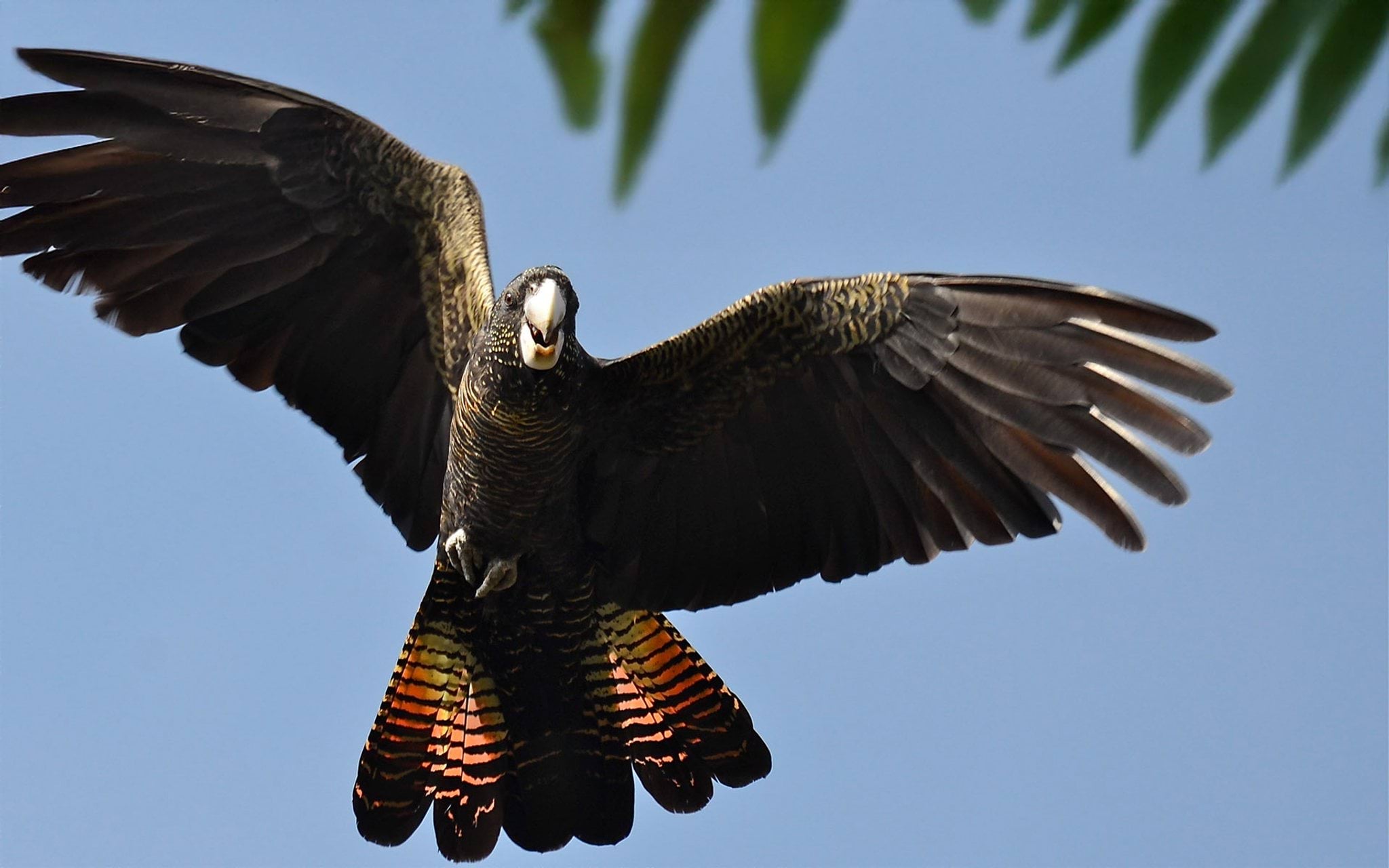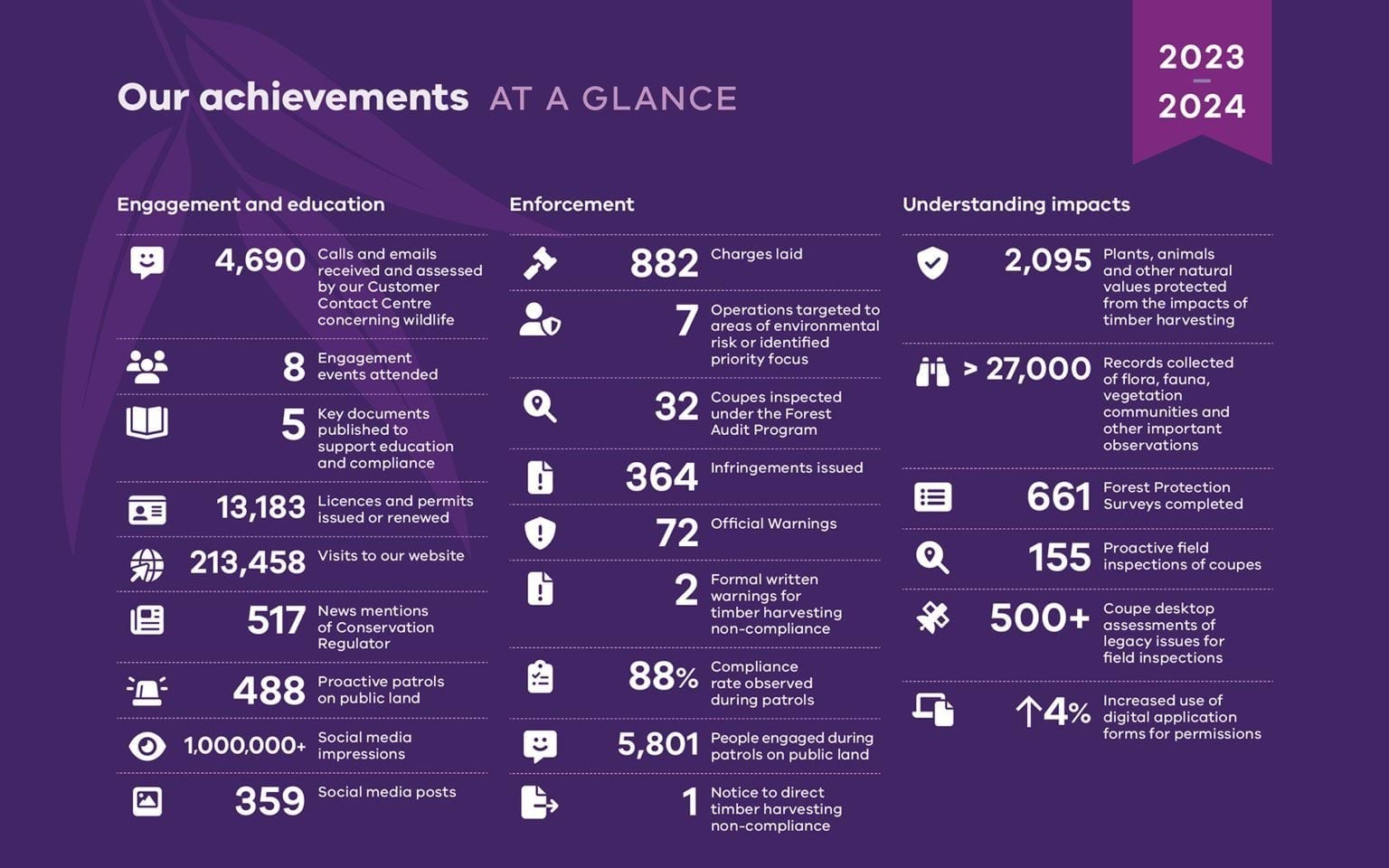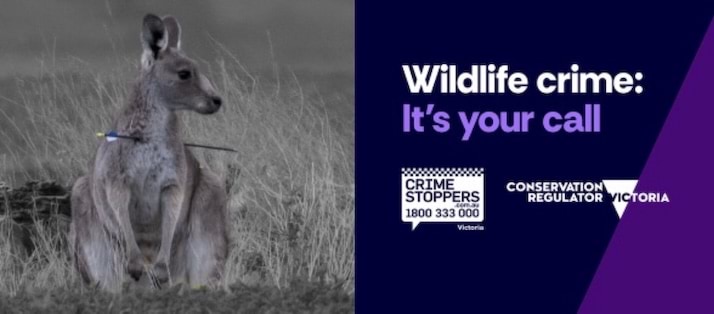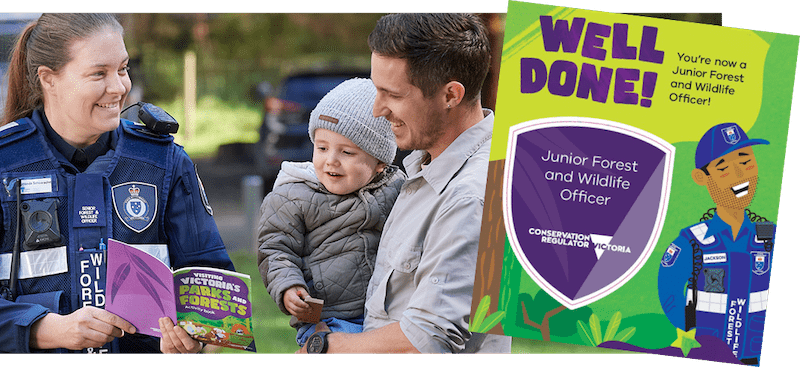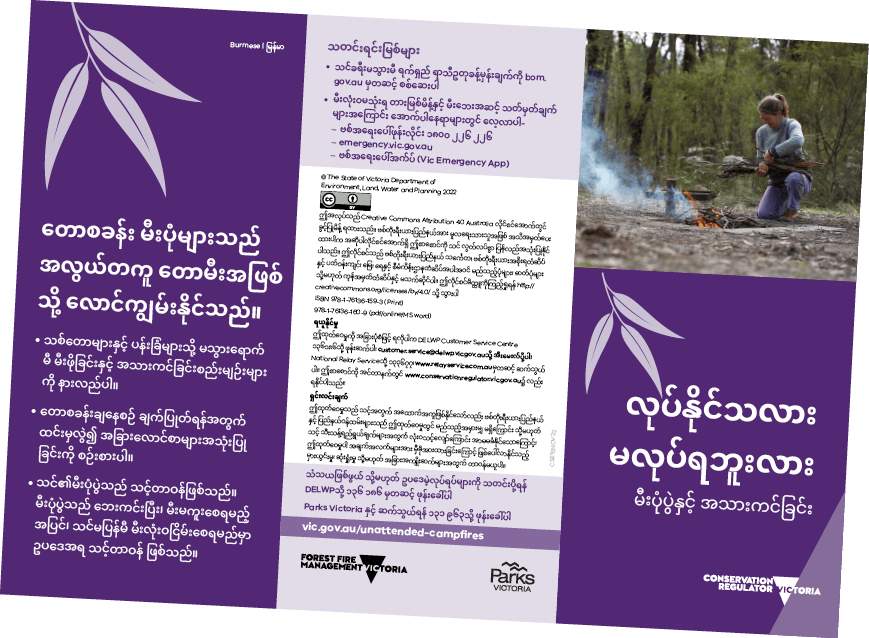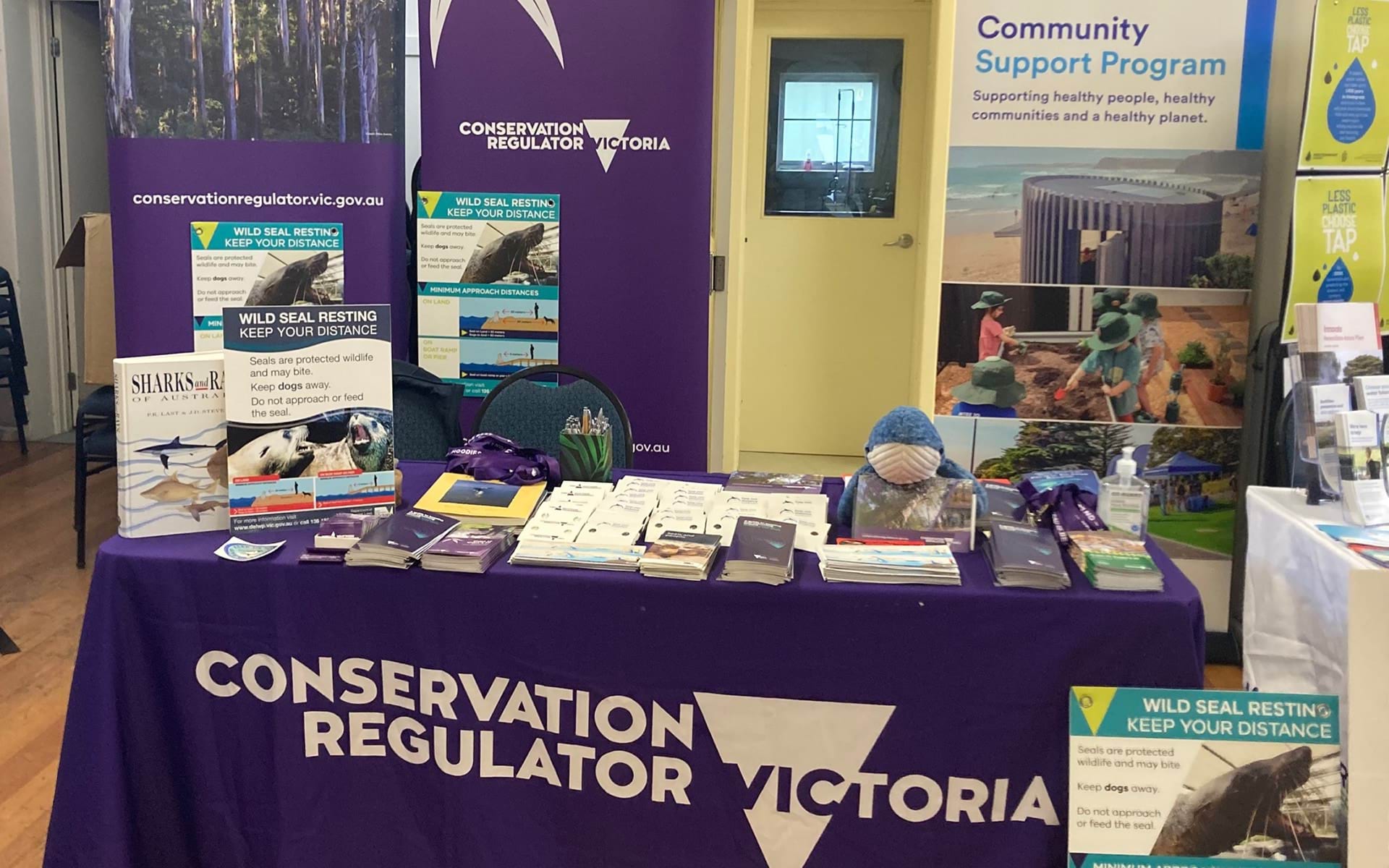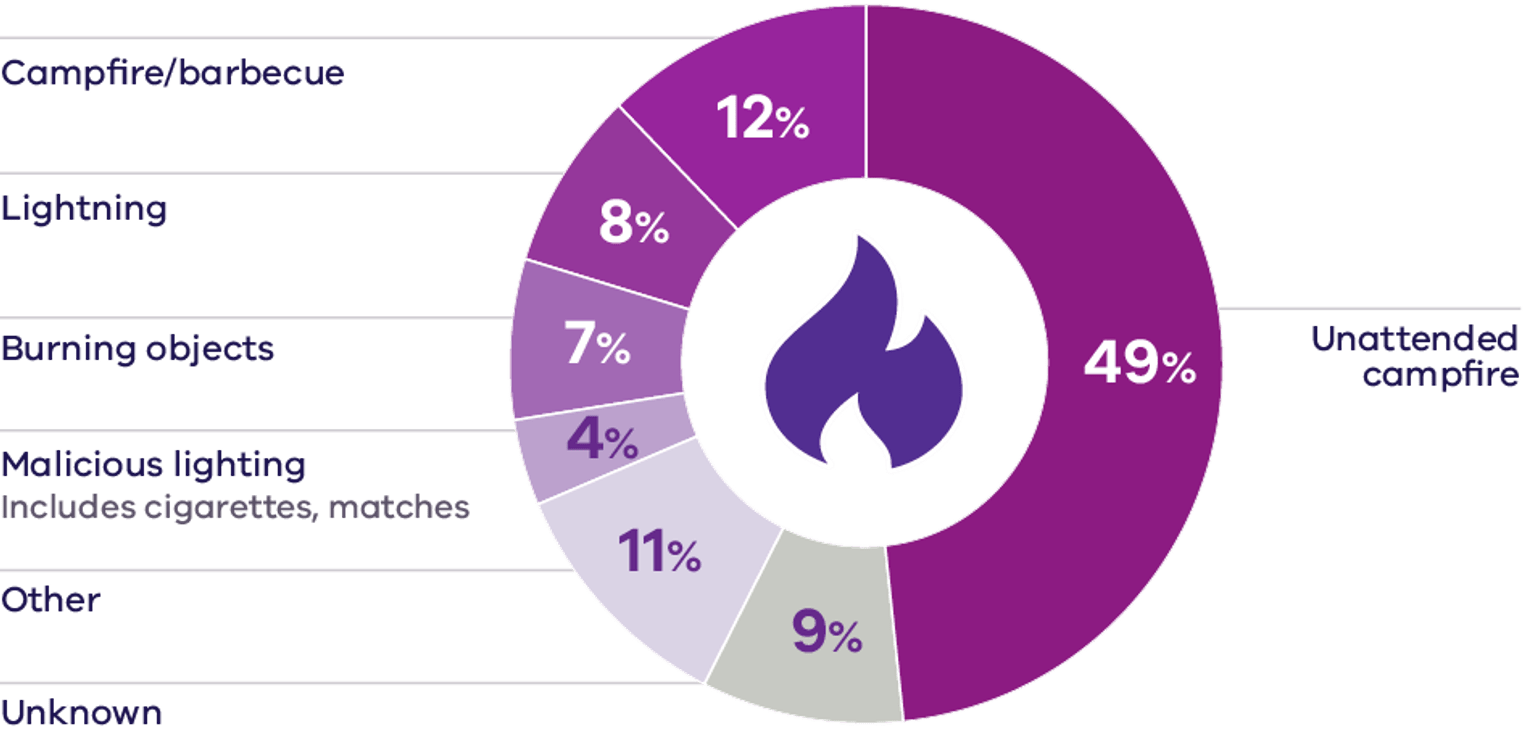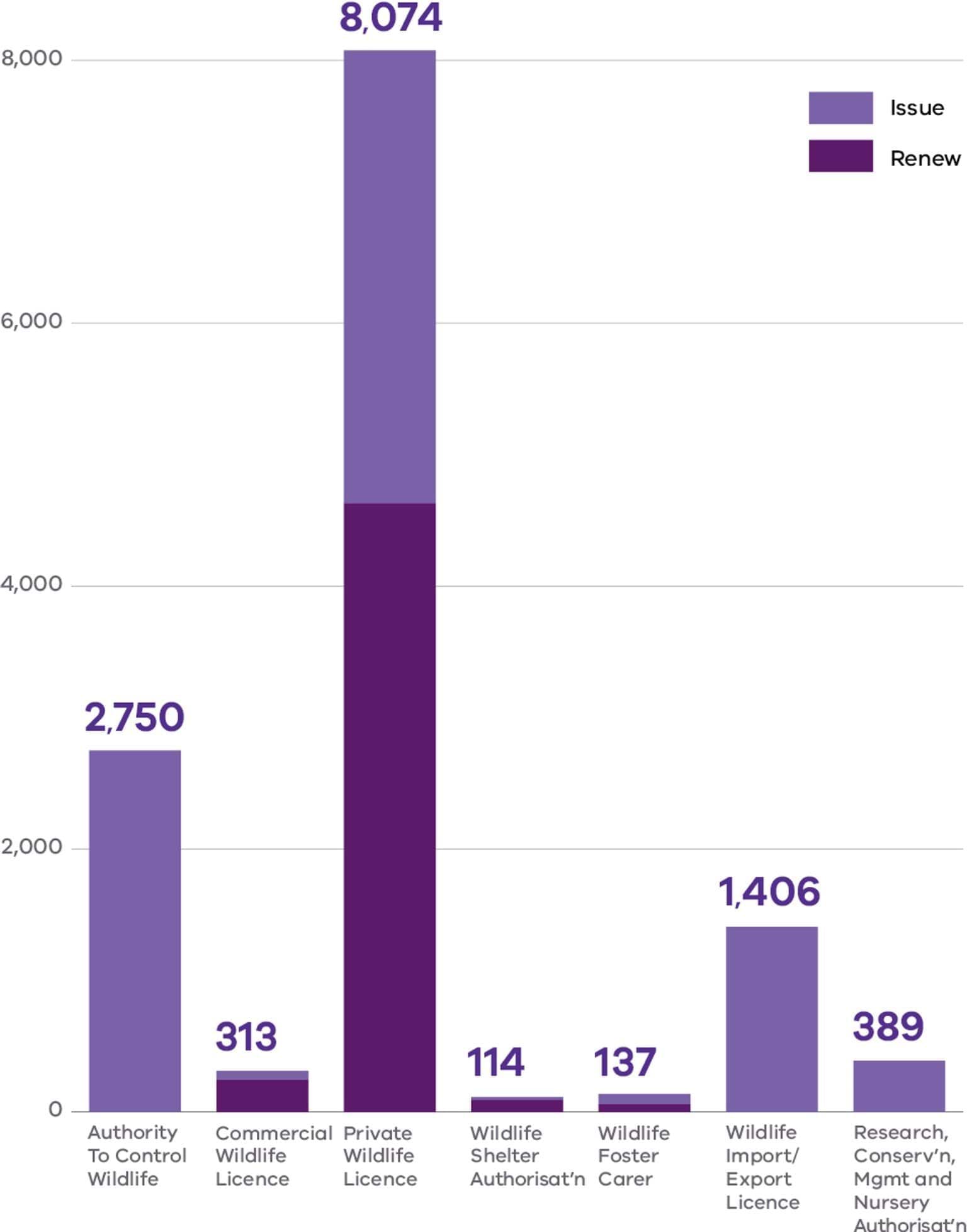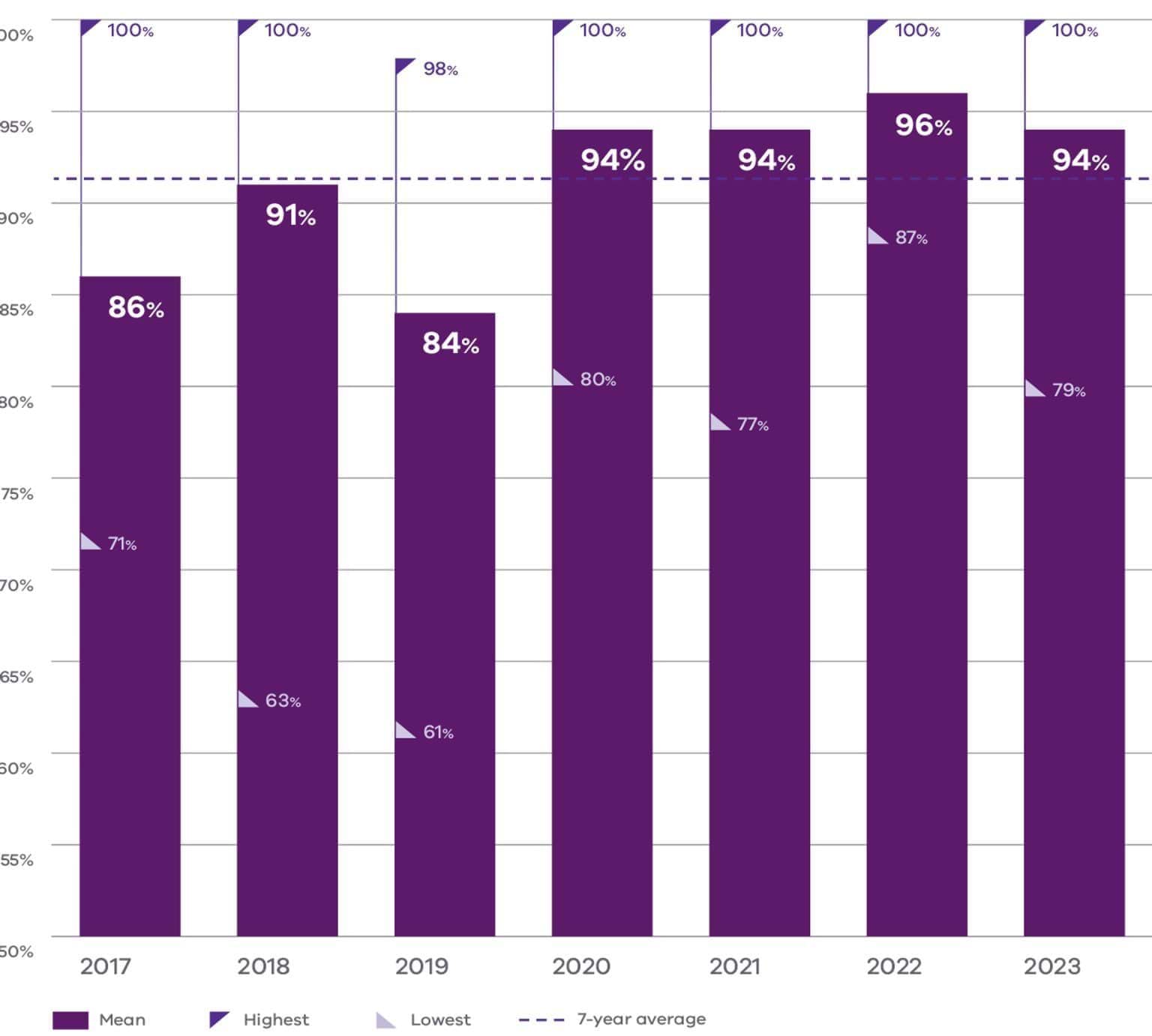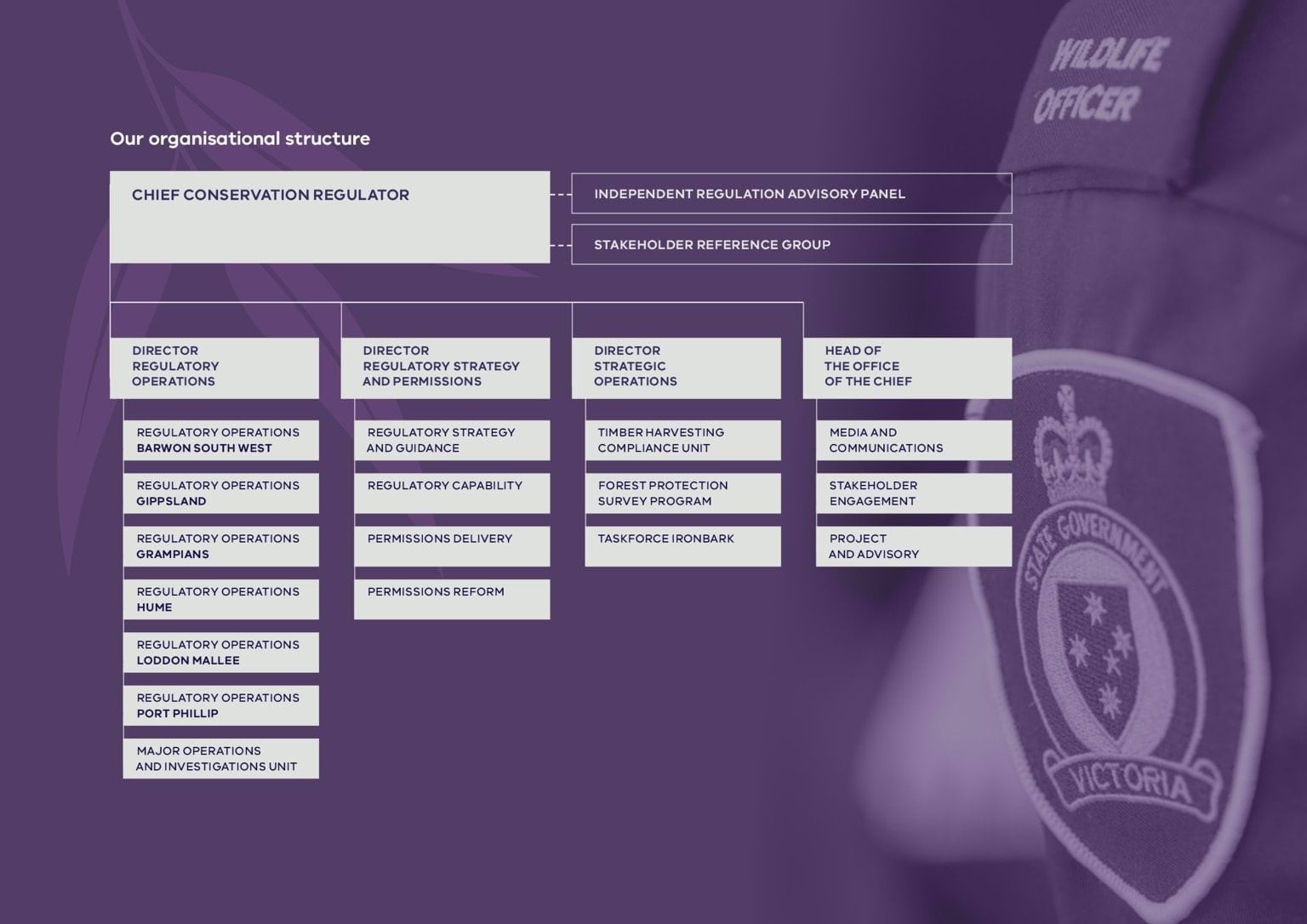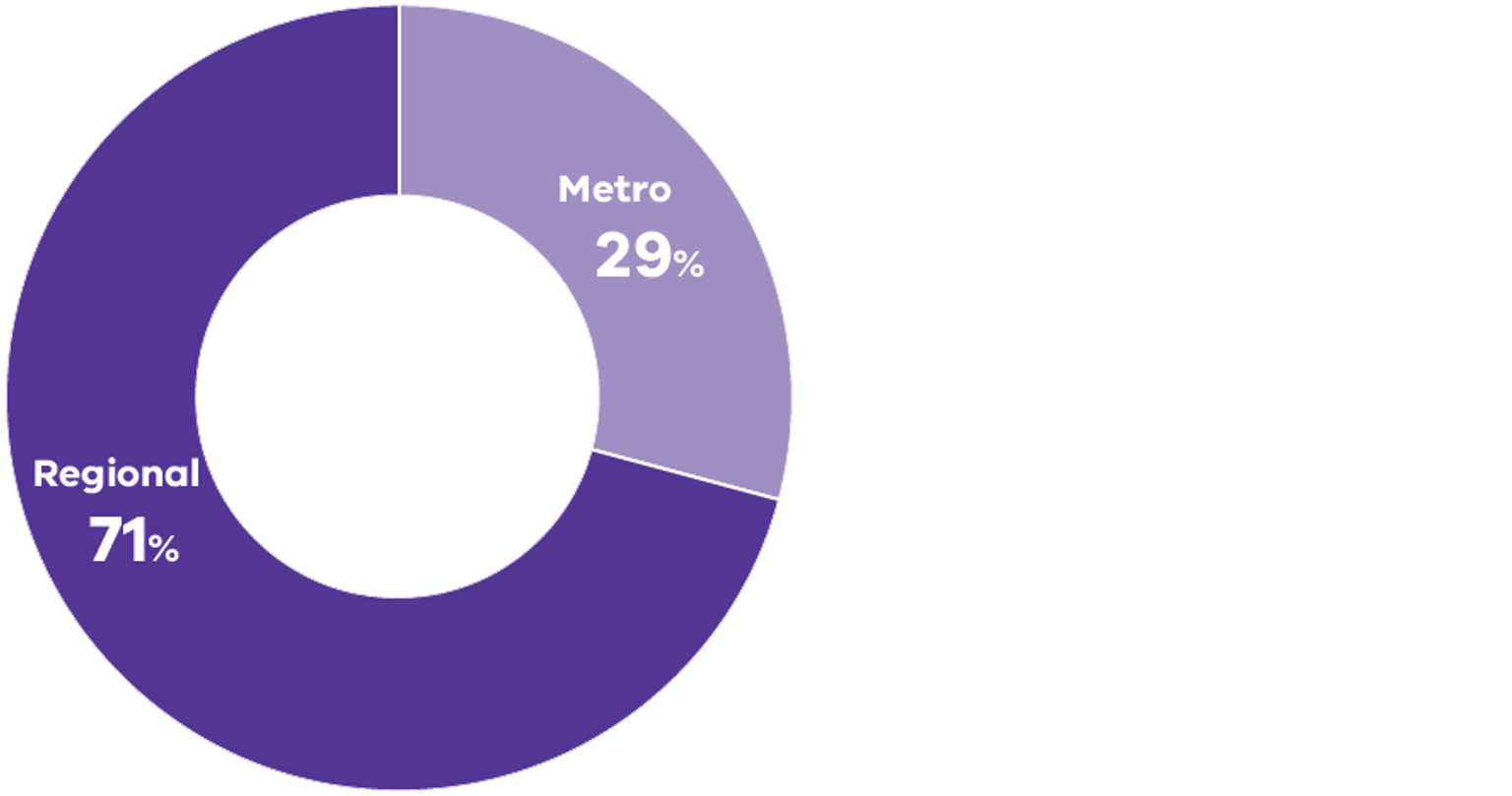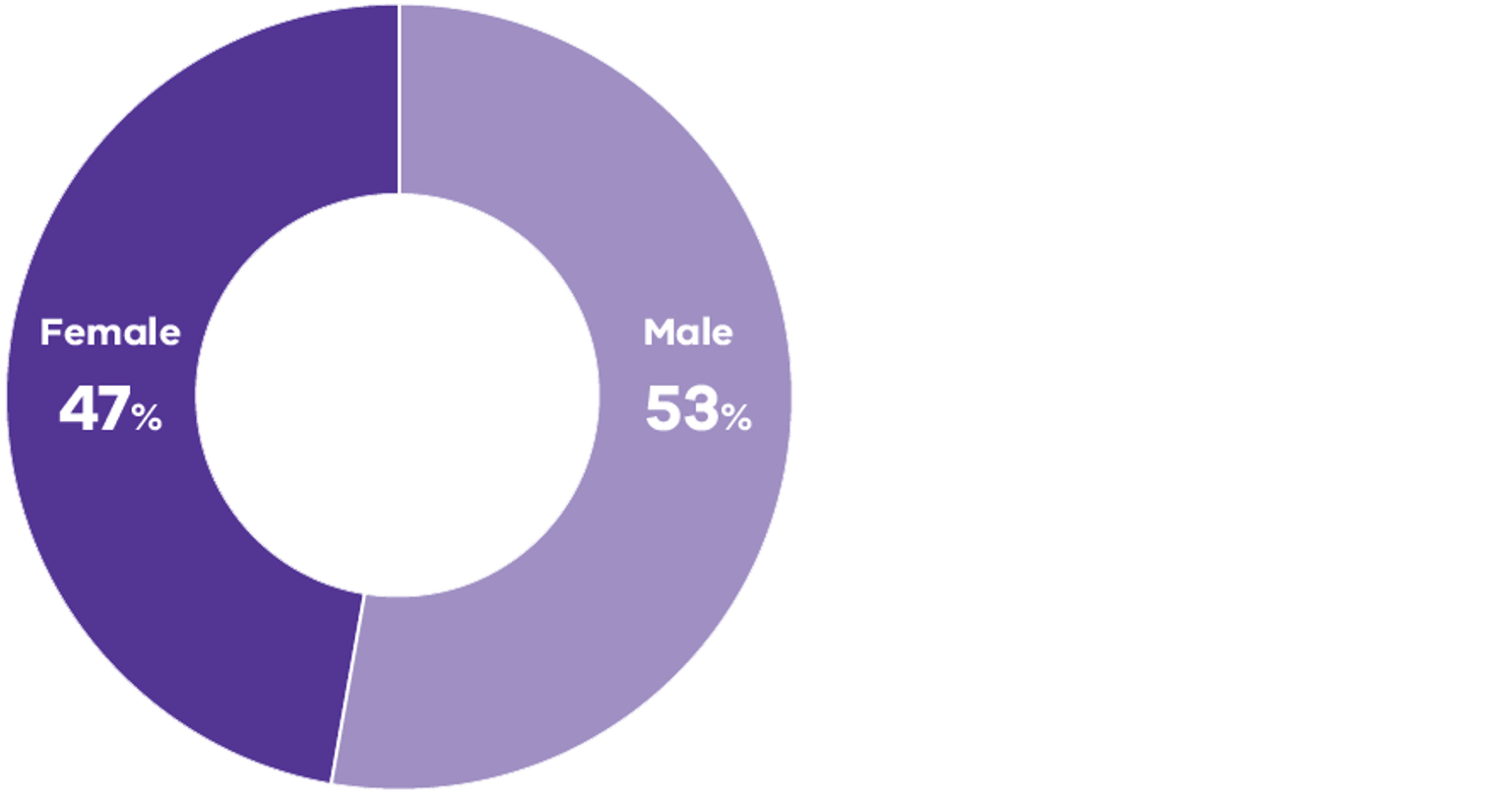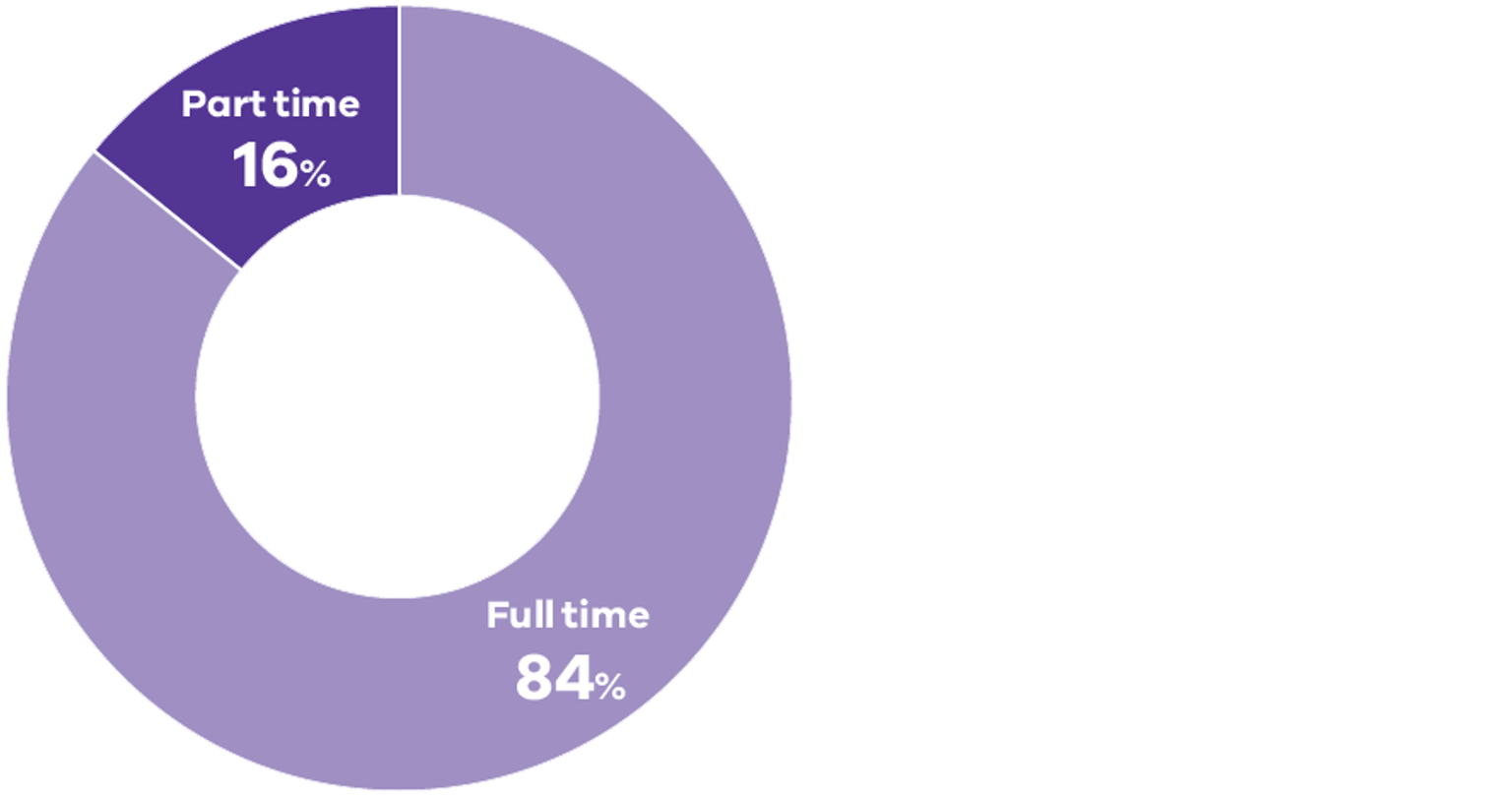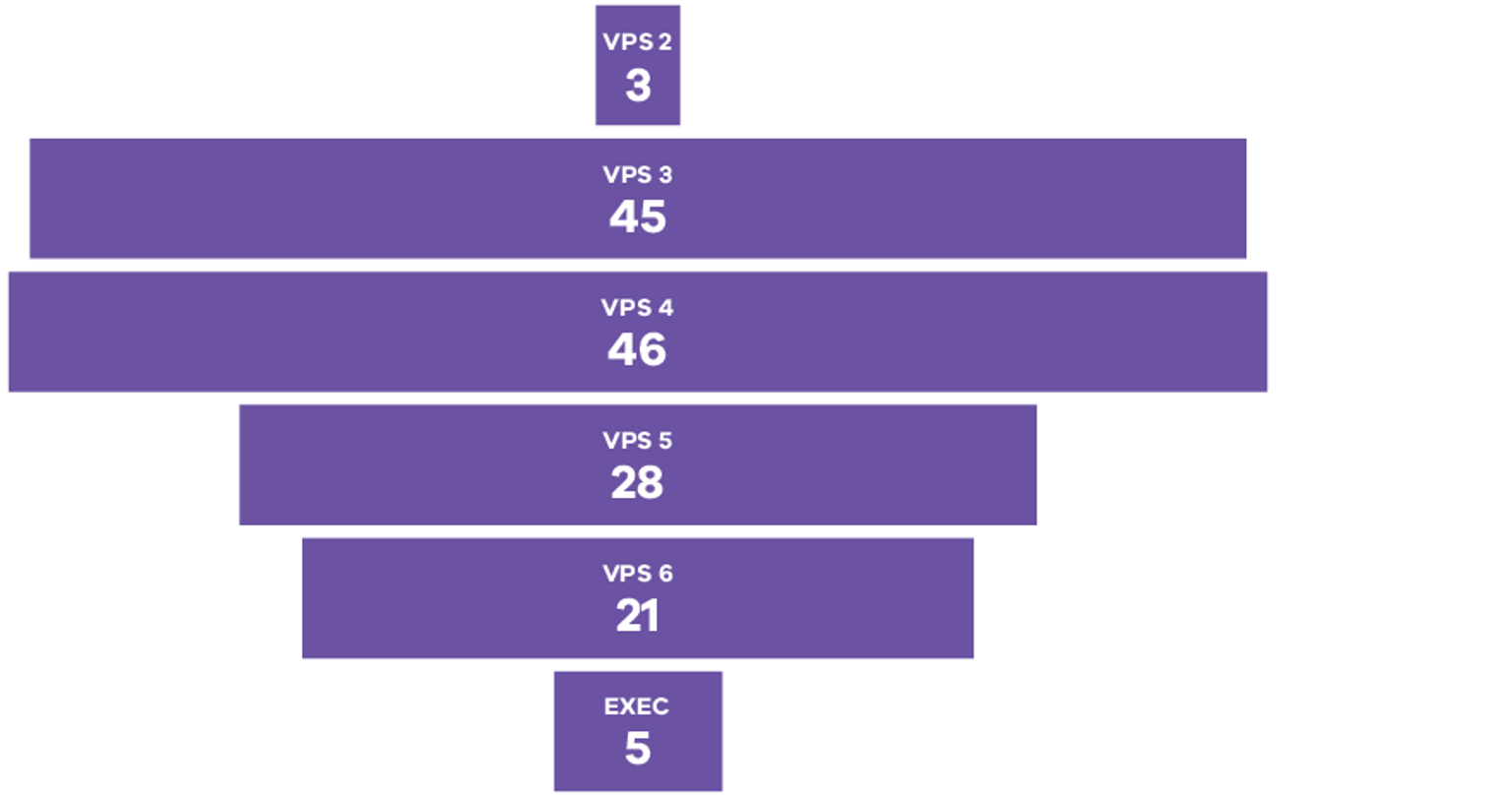- Published by:
- Conservation Regulator
- Date:
- 9 Jan 2025
This year has seen an increased focus on education and engagement activities. We are strengthening relationships with our partners and key stakeholders to deliver education initiatives for the community more broadly. Engaging with the community and identifying education opportunities enhance our operational effectiveness by encouraging voluntary compliance.
Chief's message
Conservation Regulator Year in Review 2023-2024
Kate Gavens
Chief Conservation Regulator
Welcome to the Conservation Regulator’s Year in Review for 2023–2024. This year there have been significant achievements across the Regulator with strong outcomes in engagement and education and several substantial compliance and enforcement outcomes.
Once again, we have engaged with the community by participating in local events and ensuring our presence and visibility on public land through proactive patrols across Victoria. We’ve also worked with our youngest Victorians, launching primary school education resources to help educate kids and their families about protecting the environment.
The Conservation Regulator has increased its focus on getting the community to report wildlife and forest related non-compliance including through dedicated campaigns with CrimeStoppers Victoria.
As a result, we have seen the number of reports of illegal and deliberate harm to wildlife and our forests increase this year which has helped us take appropriate regulatory action on important animal cruelty and biodiversity cases. I want to thank the members of the community who have taken the time to report any suspicious activity they have seen as it makes a significant contribution to our work.
This year we have had success in taking enforcement action in a number of key areas of wildlife and forest crime. We finalised our investigation into the discovery of starving and injured koalas at a Cape Bridgewater property in 2020, with cumulative fines of $133,000.
We successfully prosecuted a number of individuals for animal cruelty resulting in fines and community correction orders and, we laid 248 charges for illegal take of firewood, supporting our crackdown on the black-market firewood trade.
I hope you enjoy reading about our achievements in this Year in Review. I look forward to what we will achieve in 2024-25 with your help and being able to share it with you again next year.
About us
Conservation Regulator Year in Review 2023-2024
The Conservation Regulator is responsible for the regulation of public land use, native wildlife, biodiversity and fire prevention. We are a specialist regulator, established within the Department of Energy, Environment and Climate Action (DEECA).
Our approach is graduated and proportionate. We seek to educate by explaining the risks and impacts of actions on forests and wildlife. We monitor compliance with relevant laws, investigate alleged breaches of these laws and as appropriate enforce the law to achieve compliance and protect Victoria’s public land and biodiversity for current and future generations.
We work in partnership with Victorian communities, Traditional Owners, land managers, co-regulators, and other stakeholders to achieve better conservation outcomes.
Our mission, vision, and regulatory outcomes
Our mission
To be an effective, trusted, best practice regulator
Our vision
To create and maintain liveable, inclusive, sustainable communities and thriving natural environments
Our regulatory outcomes
We regulate to achieve three key outcomes:
- Equitable and safe access to public land and use of natural resources
- Protected natural and heritage values
- Sustainable communities – social, economic, and environmental
Our regulatory priorities
Regulatory priorities support the Conservation Regulator to focus efforts on the greatest environmental risk and what is most important to Victorians.
In 2023–2024, we adjusted our regulatory priorities based on a state-wide intelligence gathering, analysis and risk assessment process, and to reflect community concern for the protection of native flora and fauna. As a result, wildlife cruelty and the protection of threatened species were introduced as priority areas. Four priorities from the previous year remained unchanged, given the ongoing environmental risk that illegal off-road vehicle use, illegal campfires, and illegal firewood theft pose in state forests, and the importance of regulating native timber harvesting to the end of 2023.
Our regulatory priorities outline what we have achieved in addressing each of these areas.
2023–2024 regulatory priorities
- Illegal campfires
- Illegal take of firewood
- Cruelty to wildlife
- Protection of threatened species
- Illegal vehicle use
Our compliance and enforcement approach
The Conservation Regulator focuses effort on the most significant risks to biodiversity, wildlife and public land. We do this by considering:
- The level of risk non-compliance poses to the outcomes we are trying to achieve
- Our ability to reduce these risks
- The most effective use of our resources.
This approach recognises that it is not practical or appropriate to take compliance and enforcement action in response to every alleged or suspected breach. Our effort and actions are focused where there is the greatest risk to our regulatory outcomes, and where we can efficiently and effectively reduce that risk.
We consider factors such as whether breaches of the law were intentional, reckless or repeated, and the impact of the breach. This means our response will be different depending on the circumstance, from providing information and advice about how to comply with the law through to imposing fines, cancelling licences and permits, or prosecuting for serious offending.
We monitor compliance with the law to prevent harm to the environment wherever possible. Through monitoring we identify non-compliance and maintain a credible threat of detecting those who are engaging in illegal activities. We also take preventative action through media, stakeholder engagement, and other educational activities, to raise awareness of regulatory requirements and how to comply with the law, as well as encouraging the community to report suspected wildlife and forest crimes.
Our achievements
Conservation Regulator Year in Review 2023-2024
Engagement and education
- 4,690 Calls and emails received and assessed by our Customer Contact Centre concerning wildlife
- 8 Engagement events attended
- 5 Key documents published to support education and compliance
- 13,183 Licences and permits issued or renewed
- 213,458 Visits to our website
- 517 News mentions of Conservation Regulator
- 488 Proactive patrols on public land
- 1,000,000+ Social media impressions
- 359 Social media posts
Enforcement
- 882 Charges laid
- 7 Operations targeted to areas of environmental risk or identified priority focus
- 32 Coupes inspected under the Forest Audit Program
- 364 Infringements issued
- 72 Official Warnings
- 2 Formal written warnings for timber harvesting non‑compliance
- 88% Compliance rate observed during patrols
- 5,801 People engaged during patrols on public land
- 1 Notice to direct timber harvesting non-compliance
Understanding impacts
- 2,095 Plants, animals and other natural values protected from the impacts of timber harvesting
- > 27,000 Records collected of flora, fauna, vegetation communities and other important observations
- 661 Forest Protection Surveys completed
- 155 Proactive field inspections of coupes
- 500+ Coupe desktop assessments of legacy issues for field inspections
- +4% Increased use of digital application forms for permissions
Our focus on education for compliance
Conservation Regulator Year in Review 2023-2024
Engaging with the community and identifying education opportunities enhance our operational effectiveness by encouraging voluntary compliance.
This year has seen an increased focus on education and engagement activities. We are strengthening relationships with our partners and key stakeholders to deliver education initiatives for the community more broadly.
Engagement in action: Wildlife crime: It’s your call!
Protecting native wildlife is everyone’s responsibility and the community plays a vital role in solving wildlife crime. In May 2024 we partnered with CrimeStoppers Victoria for the Wildlife crime: It’s your call campaign.
We know that while many Victorians care for wildlife, they may not be sure who to report illegal activity to or what details will help us investigate. Recognising the important role that community assistance plays in our investigations, this campaign helped raise awareness and educate the public about the nature and seriousness of native wildlife crime. We encouraged all Victorians to come forward with any information that could help solve cases. The Conservation Regulator has been able to close several wildlife crime cases thanks to community information, including separate matters that were resolved in court involving two men who were investigated and prosecuted following reports from members of the public alleging acts of cruelty and illegal possession of wildlife
The campaign was seen more than two million times in the media, online, in advertising and at community events. There was also a 30 per cent increase in wildlife crime reports to CrimeStoppers compared to the month before the campaign. This was a significant outcome for both agencies, and we will continue to seek new ways to build community awareness about wildlife crime.
All wildlife is protected in Victoria under the Wildlife Act 1975 and it is illegal to hunt, take, destroy, injure, or interfere with them without authorisation, with maximum penalties of $46,154 and/or two years in jail.
Report wildlife crime to CrimeStoppers Victoria
crimestoppersvic.com.au/report-a-crime or call 1800 333 000
Kids’ education
The Conservation Regulator recognises the importance of promoting a connection to wildlife and our forests with children. This year we published several primary school education resources including lesson plans. The primary school lesson plans are linked to the Victorian curriculum. The lesson plans for years one to six aim to educate students on:
- The importance of looking after the environment
- The rules that exist to protect our native plants and animals
- The role that they play in preserving the cultural and natural heritage of Victoria’s landscapes.
The importance of Victoria’s forests and wildlife are explored through videos, printable resources, outdoor activities, and play. The resources aim to support students to understand more about forests and wildlife and to understand the rules through lessons such as Looking After Places, Keeping the Wild in Wildlife and Physical Activities and Our Environment.
Find out more and view materials
cool.org/unit/guardians-of-nature-environmental-protection-in-action
Teaching kids sustainable camping with a-maze-ing activities
Engagement in action
To help make sure our youngest campers learn about protecting our forests and wildlife, the Conservation Regulator created the Visiting Victoria’s forests and parks activity book for kids.
Over summer, our Authorised Officers visited hundreds of campsites and handed out activity books to kids of all ages to help them learn about campfire safety, protecting native wildlife, and the importance of taking rubbish home. At the end of the book, kids are rewarded with a Junior Forest and Wildlife Officer badge sticker.
These activity books are designed to help kids (and their family) learn safe, responsible camping behaviours with a variety of fun activities, such as mazes, crosswords, and colouring-in. The book also features kid-friendly tips on how to protect the environment while camping.
Creating accessible brochures for culturally and linguistically diverse communities
Breaking language barriers
Some of our brochures are now available in other languages, commonly spoken by campers, recreational users and other visitors to forests across the state.
We are committed to providing accessible information to all Victorians and visitors to our state. This includes anyone from culturally and linguistically diverse backgrounds. Translated brochures give those who do not have English as a first language a better chance of understanding what they can and can’t do on public land.
These brochures are helping remove communication barriers, while also making our forests more accessible. They also help us manage risks associated with public land use.
Conservation Matters
Conservation Matters is a quarterly newsletter sent out to hundreds of subscribers (stakeholders and community members) to inform them about priority projects, seasonal compliance issues, education opportunities and regulation changes. This platform also allows us to offer more detailed information and a ‘behind the scenes’ look at the work we do.
In our 2023–2024 newsletters, key topics of focus were campfire safety, responsible firewood sourcing, operational and legal milestones and outcomes, and guidance for permit and licence holders.
Subscribe to Conservation Matters
signup.e2ma.net/signup/1982849/1927755/
Events
Each year, the Conservation Regulator attends community events across Victoria. These are important opportunities to engage directly with the public and educate the community about what we do and why.
Island Whale Festival
30 June – 2 July 2023, Phillip Island, Gippsland
Great Outdoor and 4x4 Expo
24 – 26 November 2023, Sale, Gippsland
Victorian 4WD Show
18 February 2024, Lardner Park, Gippsland
VHS Reptile and Amphibian Expo
9 March 2024, Melbourne, Port Phillip
Open Roads Rally
1 – 4 March 2024, Broadford, Hume
Wimmera Machinery Field Days
March 2024, Longerenong, Grampians
The Pet Show
13 – 14 April 2024, Melbourne Port Phillip
BirdLife Australia National Beach-nesting Birds Conference
May 2024, Anglesea, Barwon South West
Continuing our work with Traditional Owners
Rights to access natural resources
The Conservation Regulator in conjunction with representatives from Taungurung Land and Waters Council ran an information session at Alexandra for environmental regulators on Taungurung Land and Waters Council members exercising their traditional rights to access natural resources. The session was attended by our co-regulators in Game Management Authority, Victoria Fisheries Authority, Parks Victoria, and Forest and Fire Operations Division.
The session covered context and legal authority enabling Taungurung people to utilise their traditional rights over natural resources, the activities they plan to undertake, initial geographic areas where the activities will take place, steps for an Authorised Officer to undertake when encountering a Taungurung member exercising their rights, determining identity of a person claiming to be from Taungurung and key contacts within Taungurung for determining identity if it can’t be verified in the field.
Our regulatory priorities
Conservation Regulator Year in Review 2023-2024
The Conservation Regulator is committed to delivering on our regulatory responsibilities. This year we have used proactive and preventive approaches to address what matters most including a number of significant operations and investigations.
Our patrols target all our regulatory priorities and any impacts on the health and wellbeing of our forests and native wildlife. For example, regional patrols align with regional compliance priorities which may include firewood take and theft, litter and dumping and illegal off‑road driving/riding in public land areas.
Illegal campfires
Bushfires are a known and potentially devastating feature of Victoria’s landscape. Reducing bushfire risks posed by illegal and unsafe campfires has been a priority since the Conservation Regulator was established.
While the weather conditions influenced by recent La Nina conditions have reduced the risk associated with unattended and illegal campfires, the potential harms to the environment and community remains. The risk of unattended or illegal campfires escaping is elevated through the summer months and on windy days. We detect the most illegal campfires during school holiday periods and long weekends from late spring to mid-autumn.
Escaped campfires can quickly turn into large bushfires, risking the destruction of native plants and animals and heritage values, loss of access to public land, loss of personal property, impacts to community infrastructure, and in the worst cases - loss of life.
Visits to Victoria’s forests, parks and reserves are expected to continue increasing and we want to support all Victorians in making the most of public land in a safe and sustainable manner. We are committed to sustaining our efforts to engage and educate Victorians about campfire safety.
We engage with the Victorian community through targeted campaigns, patrols and messaging aimed at raising the awareness of campfire safety and regulations. This year we conducted 488 patrols on weekends and public holidays across the State, during which time 88% of people observed were acting within the law. We issued 60 infringements and detected 581 unattended campfires. The number of unattended campfires is just below the eight-year average but represents a 31% increase from 2022–2023.
In 2023–2024 approximately 50% of all bushfires were caused by unattended campfires. This is consistent with the data captured over the last eight years, which shows unattended campfires have accounted for approximately 45% of all bushfires.
Enforcement in action: 40º and 40 illegal fires on Victoria’s Labour Day long weekend
On Friday 8 March, weekend forecasts of hot, dry conditions prompted authorities to declare Saturday 9 March a day of Total Fire Ban across five weather districts: the South West, Central, Wimmera, North Central, and West and South Gippsland regions.
Despite the extreme fire danger and temperatures peaking around 40 degrees, campsites in these regions were still the busiest in the State, with many campers visiting from Melbourne. During patrols, Authorised Officers provided campers with information and resources on campfire safety and Total Fire Ban rules to ensure they minimised the risk of bushfires.
During state-wide patrols of campsites over the 2024 Labour Day long weekend, Authorised Officers from the Conservation Regulator and Forest Fire Management Victoria detected more than 40 campfires still alight during a Total Fire Ban. This number could have been much higher had officers not intervened to prevent several people from lighting fires during the day.
Authorised Officers also handed out fines and official warnings to campers caught breaching other campfire rules, including leaving their campfires unattended and failing to clear flammable materials for three metres around their fire.
Campers are responsible for being up to date with the latest fire danger ratings and restrictions, especially if a Total Fire Ban is in place, before lighting a campfire or barbecue.
Before leaving home, campers should check weather forecasts and fire warnings, which can be found online through the Bureau of Meteorology, or via the VicEmergency website, app, or hotline on 1800 226 226. And to stay informed about weather conditions and warnings from their campsite, campers should also pack a portable radio and listen to their local station for updates.
It is a serious offence under the Country Fire Authority Act 1958 to light or maintain a fire on a declared day of Total Fire Ban, attracting penalties of up to $46,154 and/or 2 years in prison. Other campfire offences in state forests and parks attract fines of between $577 and $19,231.
Check weather forecasts and fire warnings
- Bureau of Meteorology website(opens in a new window) or app
- VicEmergency website(opens in a new window) or app
- Call 1800 226 226
Illegal take of firewood
Firewood theft from public land is on the rise, with around 9,000 trees illegally cut down and taken from our parks, forest and reserves each year. The Conservation Regulator is committed to addressing this growing issue and this year we laid 248 charges linked to illegal take of firewood.
In 2023, we launched Taskforce Ironbark with Parks Victoria. Taskforce Ironbark aims to disrupt the illegal firewood trade and minimise impacts on the health of our parks, forests and reserves, while also educating the community and promoting responsible firewood acquisition and consumption.
Taskforce Ironbark is targeting firewood thieves who illegally take commercial quantities of timber from public land. Much of this firewood is then being offered for sale to unsuspecting Victorians. These cases frequently affect areas of high biodiversity and areas of cultural significance as firewood thieves target large old dead standing trees that often provide wildlife habitat.
We know firewood theft occurs across Victoria. In 2023–2024, we received the most reports from the Gippsland, Grampians, Loddon Mallee and Port Phillip regions.
Illegal firewood trade represents a large proportion of all illegal firewood information reports. Forty-four per cent of all reported take of firewood from February until June was identified as having a commercial element either due to volumes taken, equipment used, or intelligence gathered suggesting a link to sale.
In response, Taskforce Ironbark is undertaking a approach on public land to detect and disrupt this illegal activity through a risk-based and intelligence-led approach. Where we know there is widespread illegal cutting, we are focussing our resources on areas where the greatest environmental harm is occurring. The taskforce uses a variety of regulatory approaches to monitor, detect, and investigate firewood crimes which include targeted patrols, use of surveillance cameras and monitoring equipment to detect and record offending on public land.
Operation Centaur: Illegal timber felling and wildlife habitat damage costs Kyneton man
A 39-year-old Kyneton man was convicted and fined $3,000 after pleading guilty to two charges of damaging wildlife habitat and illegally cutting native red stringy-bark trees for timber in the Metcalfe State Forest in September 2022.
Parks Victoria and Conservation Regulator Authorised Officers investigated, with assistance from Victoria Police and the Game Management Authority, after the man was caught on concealed cameras using a chainsaw to illegally cut timber in the forest. The concealed cameras were installed as part of the Parks Victoria-led Operation Centaur, targeting the illegal removal of critical habitat and hollow-bearing trees on public land in the Central Highlands.
When a tree is cut into blocks or fallen and decaying logs are removed from the ground, their habitat values are destroyed.
The Metcalfe State Forest is home to a range of native wildlife that rely on tree hollows for shelter, nesting, and protection from predators, including sugar gliders and yellow-footed antechinus, as well as white-throated treecreepers and Bougainville’s skinks.
Community assistance and information is crucial to investigating environmental crime and we encourage community members to report any illegal cutting or removal of firewood to the Conservation Regulator or Parks Victoria.
Report illegal cutting or removal of firewood
Parks
Parks Victoria 131 963
Forests
Conservation Regulator 136 186
Cruelty to wildlife
As Victorians, we are lucky to share our forests with a wide range of unique native animals, and whether they are roaming free or being cared for in captivity, they all deserve to be treated humanely.
The Conservation Regulator opposes any cruelty to wildlife, and we are actively working to address and prevent intentional and significant harm to wildlife. Cruelty can involve continuous inadequate care or treatment of animals that results in their pain, suffering or death.
Examples include holdings of captive wildlife kept in substandard conditions, illegally hunting wildlife, and illegally taking wildlife from the wild, and some breaches of wildlife licences or authorisations.
The Conservation Regulator has five key objectives for the prevention of, and our response to, wildlife cruelty
1 Greater community awareness
Increase understanding of wildlife welfare in the community and improve community, stakeholder and co-regulator reporting
2 Enforcement capability
Ensure our Authorised Officers have the appropriate tools, training and resources to identify, record and respond to instances of animal cruelty
3 Appropriate permissions
Ensure our licences and permits appropriately protect animal welfare
4 Prevent harm
Monitor compliance with licences and permits with a higher risk of cruelty
5 Stakeholder communication
Ensure key stakeholders, including councils, co-regulators, non-government organisations and veterinarians understand our role in preventing cruelty to wildlife and when to refer matters to us
Operation Maitland: Case closed
In 2023-24, we finalised our major investigation into reports of injured and starving koalas at a Cape Bridgewater property in January and February 2020. Approximately 250 koalas were found at the site, and sadly, more than 70 of them were either deceased or required euthanasia. Veterinarian assessment concluded that most of the animals were suffering from severe starvation and dehydration, and many had sustained major or non‑survivable injuries.
In February 2024 the landowner was fined $34,000 without conviction after admitting to wounding, and causing or likely causing unreasonable pain, suffering, and fatal injuries to 70 koalas when he cleared habitat from his Cape Bridgewater property in 2019 and 2020. The 85-year-old man pleaded guilty to four charges under the Prevention of Cruelty to Animals Act 1986, including three for cruelty and one for aggravated cruelty, at the Warrnambool Magistrates’ Court.
The two businesses contracted by the owner were also charged. In November 2023, a forestry and earthmoving business was convicted and fined $79,000 after pleading guilty to five animal cruelty charges, including one of aggravated cruelty. In December 2022, a separate business was fined $20,000 after pleading guilty to one cruelty offence under the Prevention of Cruelty to Animals Act 1986.
In sentencing, Magistrate Lethbridge said that while the man’s actions were “not deliberately cruel”, he failed to meet his “obligations to prevent cruelty to animals. The days have long passed when contractors and farmers can ride roughshod over wildlife”.
Enforcement in action: Cruelty report
Unfortunately, wildlife cruelty can be widespread, but offences vary across the State. In 2023-24, reports of cruelty to possums were more significant in metropolitan areas, often involving poison or illegal and inhumane trapping practices. A concerning incident in Epping involved a southern boobook owl which was stuck in an illegal glue trap in a tree. The bird had to be taken to a wildlife shelter for rehabilitation before it could be released. The sale and use of glue traps for trapping animals is prohibited in Victoria.
In regional Victoria, attacks on eastern grey kangaroos with weapons, dogs and motor vehicles have become a significant concern, with several incidents involving more than 50 kangaroo deaths in 2023-24. In many of these cases, kangaroos were shot but not killed and left suffering with their injuries. We have also seen cases where mothers were killed and their joeys left abandoned.
Disappointingly, cruelty also occurs along our coastline, often towards endangered southern right whales and other marine mammals. In the last year we received reports of private vessels deliberately and accidentally moving at high speeds and nearly colliding with these whales.
There are a range of agencies and regulators who work together to ensure that wildlife in Victoria are appropriately assessed and protected, and that reports of cruelty are considered and investigated. The Conservation Regulator, RSPCA, Animal Welfare Victoria within Agriculture Victoria, and Victoria Police work closely together to prevent and address animal cruelty. Agencies collaborate to ensure the referrals of cases where necessary. There is also an established one-stop shop for reporting wildlife crime through CrimeStoppers. This was recently promoted through the Wildlife crime: It’s your call! CrimeStoppers campaign.
Permissions
An important way the Conservation Regulator promotes wildlife welfare is by issuing a range of wildlife licences, permits and authorities under legislation. We also provide guidance to licence holders and undertake compliance checks to ensure they adhere to required conditions.
In 2023–2024, 88% of applicants applied for licences through our online system, highlighting the value of our digital forms which were launched in 2022. We are continuing to enhance our digital offering, and this year the Conservation Regulator created an online application pathway for Wildlife Shelter and Foster Carer authorisations. We also published further guidance for wildlife shelters and foster carers.
Wildlife licence holders are required by law to keep up-to-date records of all wildlife in their possession. Each year, licence holders must submit an Annual Return form to the Conservation Regulator which details any changes to their collections, including if animals have been acquired, traded, or have died.
This data helps us to understand what wildlife is being held and monitor any trends, such as high death rates or concentrations of dangerous species, such as venomous snakes. We will continue to follow up with licence holders to ensure this obligation is met.
In March 2024, the Conservation Regulator also published an additional three online forms to support the regulatory requirements of wildlife licence permissions holders. This included amendment requests for licensees, the notification of escaped wildlife and the ability to request a new official Record Book. Since the launch of these forms, over 300 entries have been submitted, amounting to approximately 43 per cent of all transactions of this type.
The Conservation Regulator also educates permission holders and the community to increase their understanding of wildlife care and protection. We aim to equip individuals with the tools and knowledge they need to prevent and identify cruelty. Our guidance sets out the minimum care and condition requirements for the health and safety of native animals, as well as protecting people who legally interact with them.
In 2023–2024 we published the following new guidelines
Rehoming Wildlife
Educates individuals on how to legally rehome wildlife, including outlining the licensing requirements to do so
Veterinary Care for Wildlife
Educates vets on when and how they can legally treat sick, injured or abandoned wildlife
vic.gov.au/veterinary-care-wildlife
Permissions we are responsible for
There are many different types of licences and permits issued by the Conservation Regulator, which help ensure safe, legal, and ethical interactions between people and native wildlife.
Authority to Control Wildlife
Allows landholders and land managers who have issues with wildlife causing damage to buildings, pastures, crops, or other property, or which pose risks to human health and safety, to manage these problems. An authority may include permission for lethal and non‑lethal control methods.
Commercial Wildlife Licence
Allows for the commercial use of wildlife, including selling wildlife in pet shops, keeping wildlife in zoos, as well as taxidermy and other processing of wildlife products
Private Wildlife Licence
Allows people to keep wildlife in their private residences
Wildlife Shelter Authorisation and Wildlife Foster Care Authorisation
Allows people to care for and rehabilitate injured, ill, or orphaned wildlife for release back into the wild
Research, Conservation, Management and Nursery Authorisation
Allows people to conduct research where activities may be impacting wildlife, protected flora or fish, but are necessary for improving scientific understanding, such as attaching radio collars to track wildlife
Wildlife Import/Export Permit
Allows people to bring wildlife into or out of Victoria
Forest Produce Licence
Allows individuals and private companies to cut, dig, or take away material from state forests for personal or commercial use
Operation XYLEM: Koala management under authorisations to disturb
Operation Xylem was established to undertake inspections on blue gum plantations to directly observe koala management practices and ensure they were aligned with legal requirements.
There were 55 inspections conducted on plantation companies that had been issued authorities to disturb koalas.
We saw an increase in employee knowledge of the relevant Koala Management Plans and Authorisation to Disturb along with overall koala welfare impacted by blue gum plantations. There was a noticeable improvement in employee knowledge and attitude during inspections with the quality of Proof Safe data and the fact that companies were willing to self-report or report others for non-compliance. There was an increase in individual confidence which in turn created a trusted environment which saw the passing of operational intelligence onto officers during inspections.
Enforcement in action: Melbourne man convicted for “heinous” wildlife cruelty
In addition to issuing wildlife licences and permits, we undertake investigations to ensure licence requirements are being met.
A 38-year-old Melbourne man was convicted, sentenced to an 18-month Community Correction Order, and banned from keeping animals for 10 years after he pleaded guilty to 16 animal cruelty offences for failing to provide food, water, and/or shelter to the wildlife in his care and causing the death or euthanasia of three pythons and two possums from prolonged starvation or dehydration.
The Conservation Regulator investigated the matter following anonymous reports of wildlife welfare and licensing concerns, and executed a search warrant in March 2021 at the man’s home to ensure he was complying with his Commercial Wildlife Licence.
In sentencing at the Melbourne Magistrates’ Court, Presiding Magistrate Howe said the man had committed “horrific offending against native animals that had no way to protect themselves”.
Operation Hudson: Regulating protection of wildlife involved in research
Operation Hudson was a statewide compliance operation aimed at engaging with the holders of research authorisations issued under the Wildlife Act 1975 to ensure they are aware of, and adhering to, their regulatory obligations.
Research authorisations are administered by the Conservation Regulator to allow institutions and individuals to subject wildlife to procedures that have been approved by an Animal Ethics Committee.
In early 2022, the Conservation Regulator revised 14 standard conditions for research authorisations that were implemented to all new Research Authorisations. This presented an opportunity to audit and educate permit holders about their legal obligations and how to comply.
We received 82 notifications from authorisation holders, as per their authorisation conditions, during the operation which included diverse research activity such as pit-fall trapping of reptiles, radio tracking of koalas and marine-mammals surveys using fixed-wing aircraft. Of the 82 notifications received from research institutions, 55% were for surveys of coastal marine mammals.
The Conservation Regulator will continue to monitor and inspect research authorisation holders, prioritising high-risk authorisations, and will investigate any detected non-compliance with research authorisations.
Cruelty operations
In addition to laying 694 charges this year for wildlife cruelty offences, the Conservation Regulator has achieved several significant court outcomes in 2023–2024.
Summary of enforcement action
- 76 Official warnings
- 364 Infringements issued
- 157 Charges heard before a magistrate
- 77 Charges finalised with penalty
Performance measures for regulating the protection of wildlife
| Performance measure |
| 21–22 | 22 – 23 | 23 – 24 | ||
Permissions Number of Wildlife permission by type issued | Total |
| 12,222 | 13,363 | 13,183 | |
| Authority to Control Wildlife |
| 2,148 | 2,655 | 2,750 | ||
| Commercial Wildlife Licence | Total | 268 | 264 | 313 | ||
Issue | 41 | 61 | 70 | |||
Renew | 227 | 203 | 243 | |||
Private Wildlife Licence Including Dingo licence | Total | 7,377 | 8,083 | 8,074 | ||
Issue | 3,436 | 4,004 | 3,443 | |||
Renew | 3,941 | 4,079 | 4,631 | |||
| Wildlife Shelter Authorisation | Total | 257 | 316 | 114 | ||
Issue | 16 | 25 | 23 | |||
Renew | 241 | 291 | 911 | |||
| Wildlife Foster Carer Licence | Total | 246 | 235 | 1371 | ||
Issue | 68 | 34 | 80 | |||
Renew | 178 | 201 | 57 | |||
| Wildlife Import/Export Permit |
| 1,568 | 1,422 | 1,406 | ||
| Research, Conservation, Management and Nursery Authorisations |
| 358 | 388 | 389 | ||
| Sets standards, inform and educate, supporting compliance | Conservation Regulator publications | See Key publications | ||||
| Monitoring compliance | Wildlife licence holders that submitted required Annual Return | 47% | 56% | 49% | ||
| Licence, permit and property inspections conducted to determine compliance with conditions | 148 | 277 | 211 | |||
| Collaborate | Number of calls and emails received and assessed by our Customer Contact Centre concerning wildlife | 4,645 | 5,148 | 4,690 | ||
Enforcement of the law In response to non-compliance, in line with Conservation Regulator Compliance and Enforcement Policy for Wildlife | Infringement Notices issued |
| 28 | 42 | 602 | |
| Official warnings |
|
| 8 | 14 | ||
| Prosecution charges laid |
| 18 | 127 | 694 | ||
|
|
|
| |||
[1] Renewals are completed on a two year cycle, which results in a reduction in renewals every two years
[2] Dogs being brought into parks and reserves continue to be the highest infringement type year on year (22 in 2023–2024 and 33 in 2022–2023)
Protection of threatened species
Protection of threatened species was a new regulatory priority in 2023–2024. In this first year we increased our understanding of the links between regulated activities and threatened species decline, so we could help the prevention of further decline. This priority recognises the need to address the actions identified in Biodiversity 2037 and the impact we can have on arresting biodiversity decline and contributing to this Victorian Government policy.
The Sharing our Shores campaign on Phillip Island, featured posters designed by local school children to raise awareness about vulnerable wildlife visiting the coast over summer. The campaign led by Phillip Island Nature Parks in partnership with Bass Coast Shire Council and the Conservation Regulator helped educate coastal visitors about sharing the beach safely with wildlife and promoted small actions they could take to support the survival of threatened species, including the threatened, beach-nesting hooded plover.
Biodiversity 2037
environment.vic.gov.au/biodiversity/biodiversity-plan
We also attended and presented at the Island Whale Festival at Phillip Island to educate people about our iconic southern right whales.
Another coastal campaign surrounds the Logans Beach exclusion zone near Warrnambool which is in force until the end of October to protect the endangered Southern right whales from powered watercraft and drones in the only established nursery in south-east Australia. Southern right whales are one of our most interesting species, from the way they whisper to each other to their unique white callosities, and it takes a huge amount of energy for mum to protect and raise her calf, so people are asked to admire from afar to help protect these gentle giants.
For the third year running, we partnered with BirdLife Australia and Parks Victoria for Operation Save our Hoodies (SoHo). This is an initiative educating beach-goers about keeping their distance from hooded plovers and their nests, and taking enforcement action when these rules are broken to support this vulnerable species during their crucial breeding season.
Last breeding season from September 2023 to April 2024, Authorised Officers conducted 260 patrols along the Victorian coast and engaged with more than 1,600 people. In this season, Birdlife monitored 152 breeding pairs along Victoria’s coastline and recorded 61 chicks that survived to become juveniles compared to an estimate of 40 in the previous season.
In promising news, authorities also found more beach-goers doing the right thing, issuing only 32 fines – down from 83 in 2022–2023 – to people for various offences, including disturbing birds and dog owners not complying with rules near hooded plover habitat.
We developed a new program to raise awareness about the small changes people can make to protect wildlife in the wild and in captivity. The Focus Species Program is set for launch in 2024–2025 and will feature six native species that are directly impacted when people don’t follow environmental rules. The Focus Species Program is a scalable initiative, and we hope to create further resources and feature more of our amazing native species in the future.
Taskforce Ironbark has developed a new internal geospatial tool which provides a platform to overlay critical data sets which supports our intelligence-led and risk-based approach. One key feature of the tool is the development of a new Strategic Biodiversity data set which when overlaid with illegal take of firewood reports, gives Authorised Officers the ability to target areas where illegal activity is likely to cause the greatest environmental harm.
Victorian State of the Environment Report 2023: Biodiversity
Victorian State of the Environment Report 2023 shows that biodiversity is declining and more frequent bushfires means more land is below the tolerable fire interval. Habitat loss and degradation, human population, land clearing, environmental weeds and invasive herbivores and predators are major drivers.
Our work is part of government wide effort to reverse this trend as outlined in Biodiversity 2037. Biodiversity 2037 is Victoria’s plan to stop the decline of our native plants and animals and improve our natural environment. Launched in 2017, Protecting Victoria’s Environment – Biodiversity 2037 (Biodiversity 2037) presents a long-term vision for Victoria’s biodiversity supported by two overarching goals:
- Victorians value nature
- Victoria’s natural environment is healthy.
Of particular relevance to the role of the Conservation Regulator are the following goals:
- Increase the collection of targeted data for evidence-based decision making and make all data more accessible. This has been supported by the Conservation Regulator’s Forest Protection Survey Program and will be supported in the future through the Biodiversity and Threatened Species Survey program.
- Raise the awareness of all Victorians about the importance of the state’s natural environment. This is supported by the educational programs particularly targeting children this year.
- Increase opportunities for all Victorians to have daily connections with nature and act to protect biodiversity. This is supported by our focus on promoting forest use and education on safe and legal practices in our forests and our proactive campaigns including protecting habitat by reducing illegal firewood take.
- Better care for and showcase Victoria’s environmental assets as world-class natural and cultural tourism attractions. This is supported by patrols looking to educate and enforce laws and regulations that protect the environment from bushfires and destructive consequences of dumping, illegal vehicle use.
Illegal vehicle use
Trail bike riding and four-wheel driving on public land continued to increase in popularity in 2023–2024. We know riding and driving are incredible ways to explore Victoria’s varied landscapes, but the rules must be followed to ensure these activities do not come at the expense of our natural environment and critical infrastructure such as roads and tracks.
You can drive vehicles such as four-wheel drives and trail bikes in state forests so long as you have a licence, follow Victorian road rules, drive only on formed roads and tracks, and not in a way that damages the environment.
Illegal vehicle use is a major issue for state forests due to the impacts it can have on ecosystems, flora and fauna and public safety. The most common types of vehicle-related offending are breaches of seasonal road closures and illegal off-road use of trail bikes and four-wheel drives. Offences are more concentrated between March and October, with approximately a third of observations recorded in the Gippsland region. This year we issued 109 infringements linked to illegal vehicle activity on public land.
We have been working hard to combat illegal vehicle use, through patrols to proactively monitor activity, enforce the rules, and engage and educate members of the public. Collaborative patrols have been carried out in several regions with co-regulators including Victoria Police and Parks Victoria. We also had a presence at several community events, where our aim was to empower individuals to make the right decisions concerning their trail bike and four-wheel drive use when in state forests.
Impact focus: 600+km of unique southwest environment and cultural heritage destroyed by illegal single trail riders
In August 2023, we revealed the devastating effects of illegal off-road motorcycle riding in Victoria’s Anglesea and Otway areas. More than 600 kilometres of illegal single trails have been created in the Great Otway National Park and Otway Forest Park by trail bike riders who are causing irreparable environmental damage and risking the survival of native species and Aboriginal cultural heritage.
Illegal single trails are created when trail bike riders illegally leave formed roads and drive a path through native bushland. The trails often follow established wildlife corridors, revegetated land management paths and mountain bike or walking tracks which are not made for heavy motorbikes. These tracks cause environmental destruction with long-term consequences, including habitat disturbance, soil damage and erosion, spreading weed species and damage to cultural heritage sites. Erosion and unnatural changes to water flows caused by single trails spreads weeds and disease, such as cinnamon fungus, which is increasingly killing native grasstrees across the Anglesea area.
The heathlands near Anglesea are some of the most biodiverse in Victoria and home to a range of threatened species, including several plants found nowhere else in the world, such as Anglesea Leek Orchid, Angahook Caladenia, and Anglesea Large Bearded Greenhood. Riders also seriously risk wildlife welfare by disturbing the paths animals use to move between food, water, and habitat resources.
Vulnerable and endangered marsupials, such as the southern brown bandicoot and the swamp antechinus, are directly impacted by the fragmentation from single tracks, which exposes them to feral predators.
The coastal region is also rich with Indigenous cultural heritage and only a small percentage of historical sites have been recorded. As illegal single tracks are not planned, they have serious potential to damage culturally significant Aboriginal heritage sites and destroy Indigenous artefacts.
Conservation Regulator Authorised Officers target illegal vehicle use year-round by conducting regular patrols across public land and using intelligence-gathering methods such as concealed cameras and community reports.
In Victoria, it is illegal to take a vehicle off formed roads on public land. Anyone caught ignoring these rules faces an on-the-spot fine of $192, and a maximum penalty of $9,615 if prosecuted in court.
Report illegal vehicle use on public land
Call 136 186
Operation Sprocket: Recreational vehicle safety and compliance
Licensed operation of trail bikes and four-wheel-drive vehicles on Victoria’s public land is recognised as a legitimate recreational activity. However, this activity can result in serious trauma because of unsafe behaviours and environmental damage if breaches of laws occur.
Recent crash data showed sustained or elevated levels of trauma and fatalities on gazetted and non-gazetted roads and trails on public land prompting the Conservation Regulator to deliver an intelligence-led engagement and regulation program that included attendance at events and planned patrols. It aimed to complement other Conservation Regulator’s regulatory priorities with the added objective to reduce the number and severity of recreational vehicle crashes, related injuries and environmental harms occurring on Victoria’s State forests, parks, and reserves.
To address these issues, we ran Operation Sprocket from March 2020 to June 2024, with support from the Transport Accident Commission. The mission was to improve trail bike rider safety, and reduce environmental damage caused by illegal trail bike activity in Victoria’s state forests, parks, and reserves.
Through Operation Sprocket we increased our on-ground presence through patrols, engaged with riders at trail bike events and developed education material to decrease injury on public land. Education material developed during Operation Sprocket included Ride for Tomorrow and Ride for the Future materials, tyre pressure gauges and the Personal Location Beacon safety initiative.
A total of 1,525 observations were recorded during Operation Sprocket, adding to our intelligence about the use of vehicles on public land.
The Conservation Regulator will continue to explore proactive educational opportunities for trail bike riders using the road network within the public land estate to promote undertaking these recreational activities safely, sustainability and respectfully and contribute to reducing the number and severity of injuries occurring.
Illegal vehicle enforcement actions
2022-2023 | 2023-2024 | |
| Official warnings | 25 | 26 |
| Infringements issued | 166 | 109 |
| Charges laid | 11 | 9 |
Illegal commercial timber harvesting
Commercial native timber harvesting ceased in Victoria in the 2023–2024 financial year with the Sustainable Forests (Timber) Act 2024 being repealed on 1 July 2024 along with the abolishment of VicForests. Through 2023–2024, the Conservation Regulator has ensured that monitoring, compliance and enforcement within the industry has focused on areas of high risk, in particular the cessation of the industry relating to site condition and rehabilitation.
Reports of non-compliance and threatened species detections
The Conservation Regulator continued to encourage members of the public to submit reports of alleged non-compliant timber harvesting activities. Community members were able to report threatened species or forest values found in or adjacent to planned timber harvesting locations.
Throughout the year we received eight reports of alleged non-compliance and closed 24 reports. We issued two formal written warnings and one direction for remediation to VicForests.
In 2023–2024, we received and assessed 22 threatened species reports. We processed and closed 142 threatened species reports, and all outstanding investigations relating to timber harvesting compliance and threatened species.
Forest Audit Program
The Conservation Regulator continued to deliver the Forest Audit Program. This maintained our ongoing commitment to independently review timber harvesting operations using an annual, risk‑based approach.
The program measured compliance of commercial timber harvesting operations by auditing a representative sample of coupes harvested in 2023–2024 to assess a range of target themes, including:
- Environmental compliance
- Roading compliance
- Infrastructure compliance
- Coupe planning compliance.
Independent auditors inspected 32 coupes for the 2023 Forest Audit Program. VicForests mean compliance score of 94%, was above the 7-year average of 91% and was a stabilisation of results when compared to the previous financial year. We are confident that improvements in compliance can, in part, be attributed to greater regulatory presence in timber harvesting.
Proactive coupe inspections
With the cessation of native timber harvesting, the Conservation Regulator’s proactive Coupe Inspection Program focused on regeneration and coupe infrastructure, with priority themes of waterway crossings, litter and waste, regeneration and access and roading.
Our commitment was to inspect 30 coupes each year. In 2023–2024, we made an active decision to inspect a significant number of coupes to support the identification of potential legacy issues on previously harvested coupes. We conducted 155 proactive field inspections supported by desktop assessments of over 500 coupes using aerial photography and other datasets relating to timber harvesting. 14 per cent of the 155 coupes were determined to require further assessment and remedial measures to manage the risk of harm to the environment and human safety.
Regulating Victoria’s Native Forests: Victorian Auditor General’s Office report
In October 2022, the Victorian Auditor General’s Office (VAGO) published its report Regulating Victoria’s Native Forests. The report focused on the Conservation Regulator’s approach to responding to community reports submitted via our Forest Reports portal.
The VAGO report made a range of findings about the Conservation Regulator’s approach to regulation and acknowledged the significant progress made since the Regulator’s inception. The report outlined ten recommendations for improvement, which were all approved or approved-in-principle by DEECA.
Eight of ten recommendations were finalised in 2022–2023 and 2023–2024. The final two recommendations have been discontinued as they are no longer relevant given the cessation of commercial native timber harvesting. See Appendix A for details of each recommendation.
Statement of Regulatory Intent for Timber Harvesting Regulation
In 2019, the Conservation Regulator released its Statement of Regulatory Intent for Timber Harvesting Regulation. We committed to publicly reporting on an annual basis on the Statement’s performance measures. Performance measure results for timber harvesting compliance provides an update on each of the measures contained in the statement.
Forest Protection Survey Program
The Forest Protection Survey Program (FPSP) continued to conduct pre-harvest surveys to identify threatened or high-value biodiversity species in areas of state forests scheduled to be harvested. The surveys helped record observations of target species required to be protected by VicForests.
The FPSP operated for over five years, during which time around 105,000 observations of threatened species were made. The success of the FPSP has given rise to the Biodiversity and Threatened Species Survey (BaTSS) program, which will progress towards surveys of areas proposed for the department’s forest and fire land management works.
Performance measure results for timber harvesting compliance
| Performance measure | Target | Result | Comment |
| Per cent of coupes planned for timber harvesting that have been assessed in the Forest Protection Survey Program for the potential presence of target flora and fauna | 100% | 100% | Target met |
| Per cent of coupes planned for timber harvesting that are field surveyed under the Forest Protection Survey Program with the potential presence of target flora and fauna | 64% | 64% | Target met |
| Acknowledge receipt of reports of non-compliance (Workdays) | <2 | 1.67 | Target met |
| Commence the verification of threatened species reports[1] (Workdays) | <5 | 1.67 | Target met |
| Number of coupes harvested in previous year that were audited as part of the Forest Audit Program | 30 | 32 | Target met |
| Number of coupes in which timber harvesting is underway or completed, that are subject to compliance inspection (includes spot checks for rainforest) | 30 | 155 | Target met |
| Average time taken to investigate alleged or suspected non-compliance (Months) | <12 | 11.96 | Target met |
[1] Conservation Regulator verifies threatened species reports where there is a relevant management action in the Code of Practice for Timber Production 2014, and where there is sufficient information in the report to enable verification
Activity measures for timber harvesting related reports in 2023–2024
| Activity measure | Result |
| Threatened species reports received | 22 |
| Threatened species reports that underwent verification | 7 |
| Threatened species reports closed (including from previous year) | 142 |
| Reports of alleged or suspected non-compliance received | 8 |
| Reports of alleged or suspected non-compliance investigated | 5 |
Key publications
We published several documents during 2023–2024 to help community and industry members understand where we focus our efforts, and how the public can support compliance and prevent harm from occurring.
Regulatory Priorities
Each year the Conservation Regulator identifies and implements a set of regulatory priorities. These priorities help us ensure our focus is on the greatest environmental risks, and what is most important to the Victorian community.
vic.gov.au/ regulatory-priorities-2024-2025
Rehoming Wildlife Guide
Educates individuals on how to legally rehome wildlife, including outlining the licensing requirements to do so.
Veterinary Care for Wildlife Guide
Educates vets on when and how they can legally treat sick, injured or abandoned wildlife.
vic.gov.au/veterinary-care-wildlife
Dingo fact sheet
Information about the dingo unprotection order in north-west Victoria due to new scientific information about the local dingo population’s imminent risk of extinction
vic.gov.au/dingo-protection-north-west-victoria
Wildlife management plan guidance
Guidance on how to prepare a wildlife management plan
vic.gov.au/preparing-wildlife-management-plan
Systems, processes, and tools
We are always looking for ways to improve our systems, processes, and tools, to enable more effective and efficient regulation. The Conservation Regulator has been working to progressively procure and implement modern business systems, including digitising regulatory interactions where appropriate to reduce unnecessary paperwork and the associated delays.
Projects and status
Licensing system
Procurement of a new licensing system to further improve the administration and the digitisation of our licences and permits.
Status: Underway
Case management system
Our new Case Management System was delivered in 2023–2024. This new system is designed to enhance our efficiency by automating processes and reducing administrative tasks. It will also help improve our investigative practices, collection of intelligence, and support our people to make good regulatory decisions.
Status: Complete
Digital application forms
In 2023–2024 we created an online application pathway for Wildlife Shelter and Foster Carers authorisations. This followed digitalisation of most licence and permit applications, as well as the annual returns form in 2022–2023.
Status: Complete
Our people and governance
Conservation Regulator Year in Review 2023-2024
Our Conservation Regulator Executive Leadership Team plays a pivotal role in guiding the governance of the Regulator. Supported by internal governance structures, the Executive Leadership Team provides advice and support that enables the Chief Conservation Regulator to fulfil the Chief’s responsibilities, and oversees the areas of strategy, finance, risk, people and culture, information systems and operational performance.
Our organisational structure
The Conservation Regulator is led by the Chief Conservation Regulator and is comprised of four business areas.
Regulatory Strategy and Permissions
The Regulatory Strategy and Permissions Branch leads the provision of regulatory strategy, information and guidance, and capability development. It undertakes reform and delivery of regulatory permissions (licences, permits and authorities). The branch works closely with the Regulatory Operations and Strategic Operations Branches to ensure its work can be effectively implemented and to support efficient, effective, and transparent regulatory service delivery.
Regulatory Operations
The Regulatory Operations branch leads and coordinates state-wide regulatory service delivery. Branch staff are responsible for conducting complex risk assessments, harm prevention campaigns, audits, inspections, investigations, and intelligence functions. The branch delivers strategic and effective risk-based and intelligence-led approaches to compliance for biodiversity, fire prevention, and use of public land through implementation of best practice frameworks, policies and supporting procedures and guidelines. The branch builds community confidence in the regulatory practices by implementing an open and transparent approach to information-sharing and decision-making, and by engaging with communities to inform how and where regulatory effort is targeted to address the greatest risks of environmental harm.
Strategic Operations
The Strategic Operations Branch oversees key operational activities relating to timber harvesting and delivers on the strategic priorities of the Conservation Regulator. This includes the Timber Harvesting Compliance Unit, Taskforce Ironbark and the Forest Protection Survey Program.
Office of the Chief
The Office of the Chief leads and delivers on strategic projects, issues management, reporting, media and communications, stakeholder engagement and partnerships, as well as coordinating business planning and culture development functions. The Office of the Chief works with other Conservation Regulator branches, the Office of the Deputy Secretary, DEECA’s regional and corporate media and communications units, and co-regulators to support our mission and regulatory obligations.
Chief Conservation Regulator
- Independent Regulation Advisory Panel (dotted line relationship)
- Stakeholder Reference Group (dotted line relationship)
- Director Regulatory Operations
- Regulatory Operations Barwon South West
- Regulatory Operations Gippsland
- Regulatory Operations Grampians
- Regulatory Operations Hume
- Regulatory Operations Loddon Mallee
- Regulatory Operations Port Phillip
- Major Operations and Investigations Unit
- Director Regulatory Strategy and Permissions
- Regulatory Strategy and Guidance
- Regulatory Capability
- Permissions Delivery
- Permissions Reform
- Director Strategic Operations
- Timber Harvesting Compliance Unit
- Forest Protection Survey Program
- Taskforce Ironbark
- Head of the Office of the Chief
- Media and Communications
- Stakeholder Engagement
- Project and Advisory
Our people
The Conservation Regulator considers that our people are our most valuable resource. We aim to support and empower staff to continue to build our regulatory capability and deliver on our regulatory mission. Operational staff conduct patrols for monitoring and educative activities they include Forest and Wildlife Officers and Authorised Officers, who have specialised training and are authorised to enforce relevant laws and regulations.
2023–2024 initiatives
Conservation Regulator Capability Framework
The roll out of the Conservation Regulator Capability Framework was used to determine strategic and individual learning needs. This Framework incorporated data covering the required skills, capabilities and knowledge for Conservation Regulator staff to do their job.
Regulatory Foundations Learning Program
The Regulatory Foundations Learning program, aimed at providing the same level of foundational understanding to all staff about our regulatory role and the context we operate within. This program, a suite of 14 eLearning modules was rolled out organisation wide.
Shadowing
A ‘shadowing’ program provides our people an opportunity to learn, share and gain insights from another person, team or area of the business, improving the sharing of ideas and knowledge across the regulator.
Learning and development programs
Design and delivery of a suite of learning and development programs, covering core mandatory training and fit for purpose initiatives such as search warrant and surveillance training.
Evolve
A bespoke leadership development program for our emerging leaders, focusing on enhancing skills in a management role. The program reflected on personal attributes and explored what makes good leaders, linking to the DEECA leadership model of working together, doing what matters and making a difference while maintaining a context of managing workload pressures.
Figures for staff with declared gender of self-described are not reported separately to protect individual privacy
Advisory groups
Independent Regulation Advisory Panel
The Conservation Regulator’s Independent Regulation Advisory Panel (IRAP) is chaired by the Chief Conservation Regulator, supported by three experts in the field of environmental regulation who work together to provide the Conservation Regulator with independent advice on best practice approaches to regulation. In 2023–2024, IRAP met four times and provided advice on:
- Emerging changes to best practice regulation
- Regulatory Foundations Program
- Developments in permissions reforms
- Conservation Regulator’s settings for regulatory policy and governance, and operational oversight
- Conservation Regulator’s Strategic Plan.
Stakeholder Reference Group
The Conservation Regulator’s Stakeholder Reference Group (SRG) provides advice and support to the Conservation Regulator to assist our mission of being an effective, trusted, best practice regulator for the Victorian community and environment. The SRG includes representatives from environmental non-government organisations, industry, local government and community organisations. During 2023–2024, the SRG met as a group four times, plus each member engaged with the Conservation Regulator on matters of individual interest.
In the past year, SRG has provided feedback and advice on:
- Engagement opportunities to connect with SRG members’ communities
- Supporting resources and guidance to help the public comply with legislation
- Developing our education and engagement approach
- Our role in working within a complex environmental regulatory landscape
- Developing our strategic approach to becoming a more mature regulator.
Budget and reporting
Conservation Regulator Year in Review 2023-2024
Detailed financial reporting is included in the Department of Environment, Energy and Climate Action Annual Report 2023–2024.
| Operational budget | $27,790,000 |
| Operational expenses | $11,300,000 |
| Staffing costs | $16,490,000 |
| Capital expenses for two unmanned aerial vehicles (UAVs) | $13,727 |
Performance reporting
The Conservation Regulator reports against four mandatory performance measures from Budget Paper 3. The outcomes of each are summarised here.
Budget Paper 3 measures
| Budget paper 3 measure | Target | Actual | Comment |
| Investigations of alleged non-compliance with the Code of Practice for Timber Production 2014 and other relevant laws are completed within the statute of limitations of two years | 100% | 100% | Target met |
Wildlife licence renewals processed by target dates There was a necessary delay in issuing a subset of Commercial Wildlife Licence and Dingo renewals due to remaking of the Wildlife Regulations 2024. The changeover in regulations coincided with the renewal period for this cohort and resulted in 41 licences being renewed outside the 10-business day target. However, the measure was within 5% variance of the target, and so was met. | 96% | 93% | Target met |
| Preharvest surveys of areas planned for timber harvesting completed | 64% | 64% | Target met |
| Strategic compliance operations implemented by the Conservation Regulator | 6 | 7 | Target met |
Ministerial Statement of Expectations
The Conservation Regulator operates in accordance with the Ministerial Statement of Expectations 2022: regulation of timber harvesting, use of public land, fire prevention, wildlife and biodiversity. We are expected to report on progress in delivering the Statement of Expectations. You can read about our progress in the DEECA Annual Report.
Conservation Regulator Statement of Expectations
vic.gov.au/sites/default/files/2024-07/Conservation-Regulations-Statement-of-Expectations-2022.pdf
DEECA Annual Report
Appendix A
Conservation Regulator Year in Review 2023-2024
The table below summarises the progress made against commitments which the Conservation Regulator is responsible for delivering in response to the Victorian Auditor General’s Office (VAGO) performance audit report Regulating Victoria’s Native Forests, which was tabled in the Victorian Parliament on 6 October 2022.
As at the 30 June 2024, eight of the 10 VAGO recommendations were complete, with the remaining two considered acquitted due to the cessation of native timber harvesting in Victoria.
Recommendation 1
Finalise its tender for a permanent case management system and plan for implementing it, with a view to integrating it with the intelligence database
| Agreed action | Status |
Accepted The Conservation Regulator is finalising its tender for a new case management system, which will be delivered in 2023/24. This system will appropriately link to the Conservation Regulator’s intelligence database (Gumnut) | Completed 30 October 2022 |
Recommendation 2
Develop a case for procuring current, higher-resolution satellite imagery that includes a cost-benefit analysis of purchasing this intelligence
| Agreed action | Status |
Accepted The Conservation Regulator will procure high resolution satellite imagery | Completed 30 June 2023 |
Recommendation 3
Develop guidance for assessing forest reports where there are allegations of widespread or systemic non-compliances so that its assessments are intelligence led and proportionate to the alleged non-compliance
| Agreed action | Status |
Accepted The Conservation Regulator will augment existing internal guidance to assist officers in assessing forest reports alleging widespread and/or systemic non-compliance so that the regulatory response is appropriately risk-based. | Completed 23 December 2022 |
Recommendation 4
Review its forest report assessment and investigations procedure to include a consistent process for requesting information to further a complaint assessment or investigation, including how, when and why to request additional information and time frames to guide responses how to calculate the statute of limitations period communicating the rationale for outcomes, including policies used, in correspondence to complainants
| Agreed action | Status |
Accepted The Conservation Regulator will augment existing internal guidance to:
| Completed 23 December 2022 |
Recommendation 5
Revise its Review of Outcome policy and address the identified weaknesses:
- Update complainants at the acknowledgement and review stage
- Provide a rationale for endorsing each case decision
- Document the rationale for a review’s outcome, for transparency and to show the judgement or evidence behind a decision
| Agreed action | Status |
Accepted The Conservation Regulator will revise its Review of Outcome policy to incorporate guidance around:
| Completed 31 October 2022 |
Recommendation 6
Develops guidance for stakeholders and the public that includes general information about the statute of limitations and how this affects Office of the Conservation Regulator’s ability to consider complaints and commence investigations and prosecutions
| Agreed action | Status |
Accepted The Conservation Regulator will publish on its website an explanation of the statute of limitations as it operates in timber harvesting regulation | Completed 28 February 2023 |
Recommendation 7
Review timber harvesting non-compliances and assess these for development of guidelines for how its stakeholders should interpret the Code of Practice for Timber Production 2014 (as amended 2022) and the Code of Practice for Timber Production 2014 (as amended 2022) Schedule 1: Management Standards and Procedures for timber harvesting operations in Victoria’s State forests
| Agreed action | Status |
Accepted
| Completed 30 June 2023 |
Recommendation 8
Develop a procedure for using injunctions and finalise the proposed policy for issuing enforceable undertakings
| Agreed action | Status |
Accepted in principle The Conservation Regulator will clarify its approach to the use of enforceable undertakings and injunctions | Completed 30 April 2023 |
Recommendation 9
Finalise and implement the Conservation Regulator monitoring, evaluation and reporting framework, including:
- Developing and implementing a timber harvesting compliance monitoring, evaluation and reporting plan
- Introducing timber harvesting compliance outcomes and indicators to measure the effectiveness of its activities
| Agreed action | Status |
Accepted in principle
| Action deemed as no longer relevant given the cessation of native timber harvesting from 1 January 2024. A Monitoring, Evaluation and Reporting (MER) framework has been developed and is being implemented. |
Recommendation 10
Review and revise its performance indicators in its Regulating timber harvesting in State forests under the Allocation Order – Statement of Regulatory Intent to include cost, quality and efficiency measures to allow for a more comprehensive and transparent view of the Timber Harvesting Compliance Unit’s performance in addressing non-compliance
| Agreed action | Status |
Accepted in principle
| Action deemed as no longer relevant given the cessation of native timber harvesting from 1 January 2024. A Monitoring, Evaluation and Reporting (MER) framework has been developed and is being implemented. |
